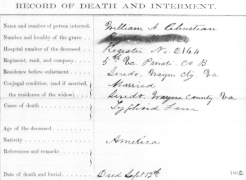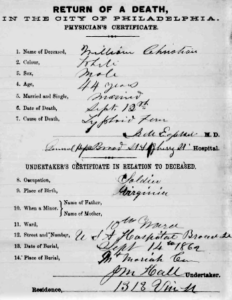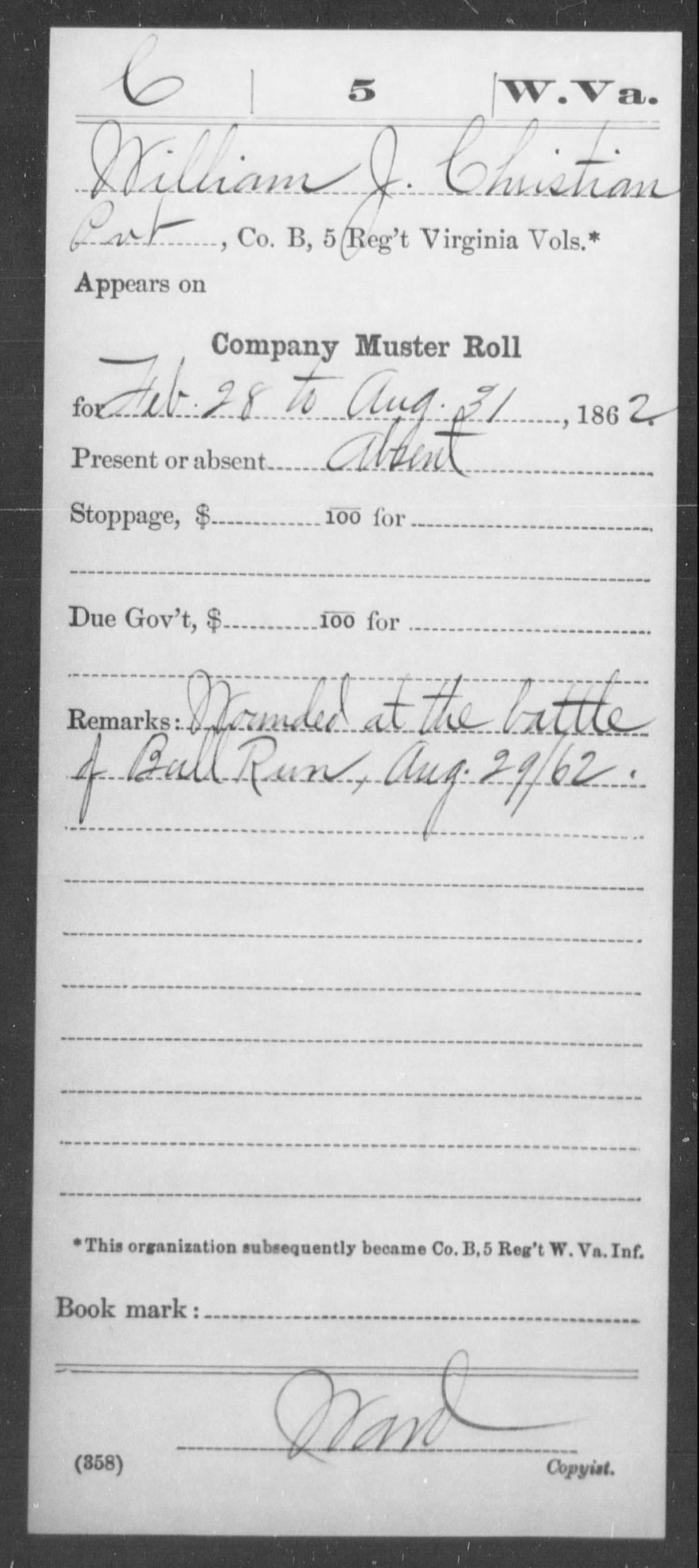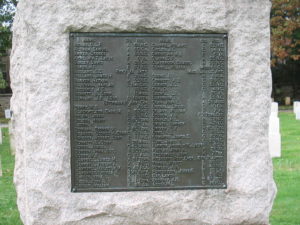Title: Army Private, "Lost Soldier of the Civil War"
Birthdate: 1830
Death Date: September 12, 1862
Plot Location:

William Jasper Christian was born around 1830 in Ceredo, Wayne County, Virginia (now West Virginia). On March 25, 1854, he married Mary Ann Hatton and they had four children. He enlisted August 14, 1861 in the 5th Virginia Volunteers, a Union Army outfit, for a term of three years. His occupation was listed as farmer.
Several sources, including a “Record of Death and Interment,” confirm that William died of typhoid fever at the Broad Street U.S. Army Hospital in Philadelphia on September 12, 1862. He may have contracted the disease while in the hospital, since he had been wounded at the Second Battle of Bull Run on August 29. According to army records, Private Christian was to be buried at Glenwood Cemetery in Philadelphia but he never got there.
 The Union Army lost track of him. This Philadelphia death certificate indicates that Private Christian was actually buried on September 14, 1862 – at Mount Moriah Cemetery. But the story didn’t end here at Mount Moriah.
The Union Army lost track of him. This Philadelphia death certificate indicates that Private Christian was actually buried on September 14, 1862 – at Mount Moriah Cemetery. But the story didn’t end here at Mount Moriah.
 In 1891, the remains of 187 Confederate Prisoners of War who died at various U.S. Army Hospitals in the Philadelphia area and buried in private cemeteries in Bucks, Philadelphia, and Delaware Counties were removed. They were consolidated in an unmarked mass grave at Philadelphia National Cemetery, Haines Street and Limekiln Pike, in the Oak Lane section of Philadelphia. Among those removed from Mount Moriah Cemetery was a Union soldier, Private William Jasper Christian, now misidentified as a Confederate POW from Company B, “5th Virginia Infantry, CSA.”
In 1891, the remains of 187 Confederate Prisoners of War who died at various U.S. Army Hospitals in the Philadelphia area and buried in private cemeteries in Bucks, Philadelphia, and Delaware Counties were removed. They were consolidated in an unmarked mass grave at Philadelphia National Cemetery, Haines Street and Limekiln Pike, in the Oak Lane section of Philadelphia. Among those removed from Mount Moriah Cemetery was a Union soldier, Private William Jasper Christian, now misidentified as a Confederate POW from Company B, “5th Virginia Infantry, CSA.”
The controversial mass grave remained unmarked and the soldiers unidentified for two decades. During this time the United Daughters of the Confederacy and factions of the Grand Army of the Republic fought a “Battle of the Monuments.” The UDC wanted to place a monument commemorating 224 unknown Confederate POWs who died in captivity at Philadelphia National Cemetery. In 1901, a former GAR Commander in Chief and president of Philadelphia’s City Council, Louis Wagner, threatened to dynamite any monument commemorating “Rebels.”
Meanwhile, in 1898 at a speech at Atlanta, President William McKinley, a Union veteran of the Civil War, advocated for the marking of 28,000 Confederate POW graves in the North. Congress agreed to appropriate funds in 1906 to establish a commission to identify and mark those graves. The controversy in Philadelphia was finally settled when a federal monument dedicated to the Confederate war dead was placed at Philadelphia National Cemetery in 1911.
 The Commission for Marking the Graves of Confederate Dead issued a report in 1912 identifying the POW graves remaining in the North. Among the Confederate POWs listed for Philadelphia National Cemetery on page 523 is Union soldier “W. J. Christian, Company B, 5th Va.,” with the date of death “Sept. 12, 1862.”
The Commission for Marking the Graves of Confederate Dead issued a report in 1912 identifying the POW graves remaining in the North. Among the Confederate POWs listed for Philadelphia National Cemetery on page 523 is Union soldier “W. J. Christian, Company B, 5th Va.,” with the date of death “Sept. 12, 1862.”
There is no record of any Confederate soldier surnamed “Christian” in the muster rolls of the 5th Regiment, Virginia Infantry, CSA. The 5th Virginia (Union) Volunteers became the 5th West Virginia Infantry in 1863 when West Virginia broke from Virginia to become a state on the Union side.
Today, Union Private William Jasper Christian’s name and unit can be found, misidentified as a Confederate POW, on the Confederate Soldiers and Sailors Monument at Philadelphia National Cemetery, third soldier from the top right column. Ironically, his wife received a widow’s pension that correctly identified his Union regiment.

Support the Friends of Mount Moriah
Help us in our mission to restore and maintain the beautiful Mount Moriah Cemetery by donating to our cause or volunteering at one of our clean-up events.

